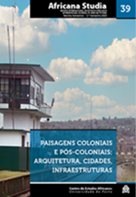The «Plan of Constantine» and the modernist utopia
Resumo
The city of Algiers experienced during the Algerian war a disproportionate increase of bidonvilles. This term, which was firstly used in the Maghreb in the late 30’s (Descloitres, 1961), represented the living conditions of the poorest indigenous populations. At CIAM 9 of 1953, ClAM-Algiers group made a remarkable presentation of the bidonville Mahieddine. By representing Algerian silhouettes through the Modulor, the goal was to seek in the vernacular and popular culture a way to renew modernity (Abram, 1999). This meticulous work gave birth to a sketch of the Muslim home cell. The latter was tested and experimented in various applications but had its climax through the housing programs of the “Plan of Constantine”. In this paper, we will try to understand how urban processes shape the territory and how this Plan dating from 1958 participated in the mutation of the Algerian landscape through the social housing experimentation carried out principally by the modern movement architects.
Keywords: Social housing, Grands Ensembles, Industrialization, CIAM 1953.
Downloads
Downloads
Publicado
Como Citar
Edição
Secção
Licença
Direitos de Autor (c) 2024 Africana Studia

Este trabalho encontra-se publicado com a Creative Commons Atribuição-NãoComercial 4.0.
Os autores cedem à Revista Africana Studia o direito exclusivo de publicação dos seus textos, sob qualquer meio, incluindo a sua reprodução e venda em suporte papel ou digital, bem como a sua disponibilização em regime de livre acesso em bases de dados.
As imagens, no caso de serem originais e enviadas por via postal, serão devolvidas se assim for explicitado pelos autores.
A Africana Studia é uma revista de acesso aberto que visa promover a divulgação e o debate da investigação científica. Todos os artigos aceitos são, portanto, publicados gratuitamente para autores e editores.




